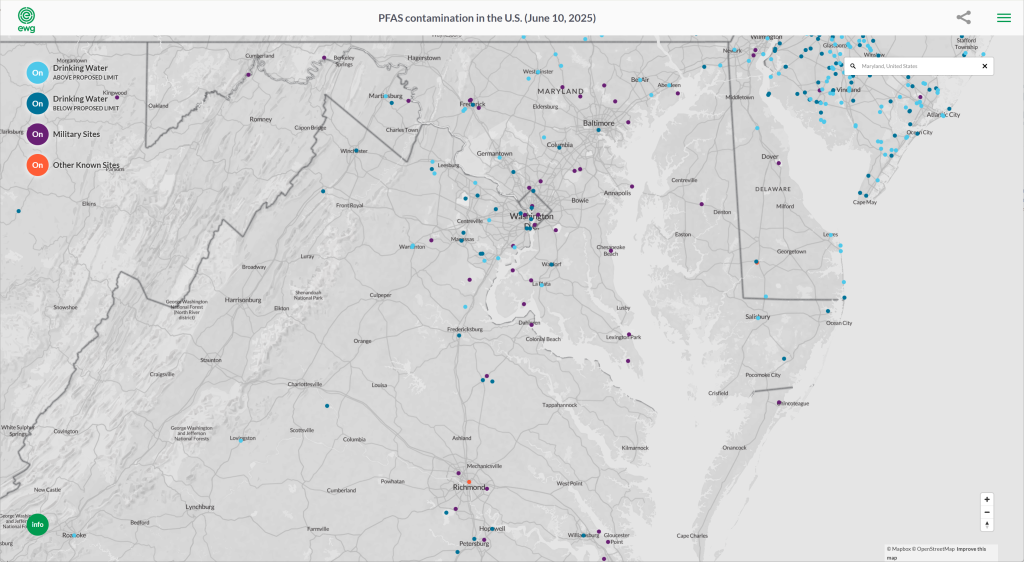- Home
- Personal Injury
- PFAS Lawsuit
- PFAS Contamination Map
- PFAS in Maryland
PFAS in Maryland
- Last updated: July 16, 2025
-
Contributor: nicky

I have closely followed the unfolding story of PFAS Maryland contamination. Many residents want to know whether their health is at risk and how to protect themselves. PFAS, or per- and polyfluoroalkyl substances, have raised serious concerns for local communities, environmental agencies, and policymakers. In this piece, I will share verified information on how these chemicals enter our water supplies, where they accumulate, and what health implications they carry.
PFAS have been called “forever chemicals” because they do not easily break down in the environment or in our bodies. In Maryland, these substances pose risks in various settings, including drinking water, soil, and local agriculture. Here, I will examine the documented evidence of contamination, the diseases linked to exposure, and the steps Maryland is taking to address and mitigate health risks.
Learn more about PFAS lawsuits. In my view, having trustworthy data is critical before making decisions about potential legal claims. This article aims to empower you with the facts so you can safeguard your life and well-being.
What are PFAS and why are they dangerous?
PFAS encompass thousands of manufactured chemicals, including two widely studied variants: Perfluorooctanoic Acid (PFOA) and Perfluorooctane Sulfonate (PFOS). These chemicals have been used in various products since the 1940s, largely for their water-repellent and non-stick properties.
According to the U.S. Environmental Protection Agency (EPA), PFAS can remain in the environment and human tissue for extended periods. Some research has found that certain PFAS accumulate in the body, possibly contributing to adverse health outcomes over time. Children may face heightened vulnerability, partly due to exposure through breast milk and in utero during pregnancy, according to the Centers for Disease Control and Prevention (CDC).
Where are PFAS found in Maryland?
In Maryland, multiple surveys and official reports indicate that PFAS contamination is not restricted to a single industrial site. Military bases, manufacturing facilities, firefighting training sites, and even consumer-product-handling locations have tested positive for these chemicals. The Maryland Department of the Environment (MDE) found PFAS in the majority of water treatment plants it tested. Statewide data also suggest that 14 percent of surveyed industries have PFAS sources on-site, posing risks to water bodies, local wildlife, and eventually humans.
Maryland’s lawsuit against major manufacturers such as 3M and DuPont underscores the concern about PFAS pollutants. This legal action seeks to recover damages for contamination in waterways, soil, and ecosystems. Further, researchers have detected PFAS in and around at least a dozen military locations, including Joint Base Andrews and Aberdeen Proving Ground. Service members and nearby residents have raised questions about possible links to cancers, notably testicular cancer.
PFAS in Maryland’s drinking water
Drinking water is one of the most direct pathways for PFAS to enter our bodies. When industrial discharge, firefighting foam runoff, or wastewater from certain factories finds its way into municipal systems or private wells, the risks escalate. Scientists have observed a heightened threat in areas near manufacturing plants and military facilities.
Known contamination sites
Multiple reports point to contamination in counties that rely on groundwater sources close to industrial operations. According to MDE findings, PFAS have been detected in conventional water supplies throughout the state. In particular, communities downriver from certain industrial complexes have reported elevated PFAS levels. Additionally, the George “Walter” Taylor Act, passed in Maryland in 2022, seeks to restrict PFAS use in firefighting foam and consumer products to curb further contamination.
Impacted counties and communities
Counties such as Prince George’s, Anne Arundel, and Harford have reported PFAS detections in water sources. In some instances, local water treatment plants have found elevated PFAS levels, prompting advisories and follow-up testing. In rural locations, private wells remain a concern. While the state provides some guidance, private well owners often bear the responsibility for testing and mitigation.
A number of residents, especially those near military bases, have pressed for more comprehensive screening. Elevated testicular cancer rates, reported in public health statistics, have motivated community groups to petition for improved regulations and transparent reporting.
State and federal testing results
The Maryland Department of the Environment has tested various municipal water supplies, noting that the vast majority contain at least trace amounts of these chemicals. In April 2024, the EPA introduced federally enforceable PFAS standards for five PFAS compounds in drinking water. However, many states, including Maryland, still wrestle with incomplete data on other PFAS substances that remain unregulated at the federal level.
The Environmental Council of the States (ECOS) has monitored PFAS in biosolids since November 2022. A survey of 34 states revealed a patchwork of testing protocols, indicating significant research gaps. Maryland is among those that have sought to tighten regulations by establishing stricter criteria, especially for drinking water.
PFAS in Maryland’s soil and agriculture
PFAS often migrate into soil through industrial waste, treated fertilizers, or firefighting foam residue. Since they resist degradation, PFAS can remain in soil for decades, affecting crop quality and potentially contaminating livestock feed.
In Maryland, agricultural communities near contaminated sites worry about crop uptake of PFAS and subsequent accumulation in the food supply. While some research suggests that PFAS do not always transfer into foods at harmful concentrations, concerns remain. State authorities encourage regular soil testing for areas known to have elevated PFAS levels, especially if produce is sold commercially.
Health effects of PFAS exposure
Some PFAS chemicals have been associated with an increased chance of kidney cancer, testicular cancer, thyroid problems, and cholesterol changes, based on multiple studies cited by the CDC. Children and individuals with compromised immune systems may be more susceptible to adverse effects.
Researchers acknowledge that the exact mechanism of PFAS toxicity can vary by chemical subtype and by dose. Accumulation over time is a principal worry. Even low-level exposure can build up, potentially raising health risks. Individuals relying on local groundwater, consuming fish from PFAS-impacted waterways, or living near industrial sites may face a higher exposure load.
PFAS-linked diseases in Maryland
Maryland’s documented PFAS pollution has raised concerns about several specific diseases. While direct cause-and-effect conclusions can be complex, the association between PFAS and certain conditions has appeared in numerous scientific papers and public-health advisories.
Kidney cancer
Kidney cancer risk has been prominently linked to PFOA, a common PFAS variant, according to the CDC. Maryland’s state agencies and local physicians have noted an increase in awareness of kidney cancer around industrial clusters. Some residents have requested medical monitoring under potential class-action suits or other legal frameworks.
Testicular cancer
Testicular cancer is another serious concern. Military installations have drawn the spotlight in recent years because firefighters used PFAS-based foams for training and live-fire exercises. The Department of Defense has confirmed contamination at or near Joint Base Andrews and Aberdeen Proving Ground. Although more research is needed, the association between PFAS and testicular cancer is strong enough that some communities are pushing for immediate remediation.
Thyroid disease
Research demonstrates that PFAS may interfere with thyroid hormone regulation. I have encountered case studies that link thyroid irregularities to moderate and long-term PFAS exposure. Individuals with existing thyroid conditions often raise questions about whether PFAS might worsen their symptoms. Maryland health officials continue to collect data to clarify these relationships.
Liver damage and cholesterol changes
Some PFAS have also been implicated in liver toxicity. Elevated cholesterol levels and hepatic enzyme fluctuations are documented in human and animal studies. Maryland’s MDE encourages residents who suspect PFAS exposure to consult healthcare providers if they experience unusual biochemical markers. These lab results, while nonspecific, can alert physicians to further evaluate environmental contributions.
How Maryland is responding to the PFAS crisis
State authorities, advocacy groups, and private stakeholders are collaborating to address the PFAS situation. Government offices realize that PFAS contamination spans water, soil, and even air. Maryland is employing multiple strategies, from legislation to legal action, to limit PFAS pollution and to hold manufacturers accountable.
Maryland Department of the Environment (MDE) actions
MDE has been proactive in testing rivers, wells, and community water systems. In addition, the department enforces industrial discharge regulations and compiles data from municipalities. MDE officials have also partnered with federal agencies to align local standards with the nationally recognized thresholds. This includes ongoing collaboration with the EPA and involvement with organizations such as ECOS for data-sharing and risk assessment.
Drinking water standards and monitoring
In April 2024, the EPA’s new enforceable PFAS limits nudged Maryland to tighten its own oversight. Many water treatment facilities are now required to submit regular sampling results. While some local systems have met or surpassed these standards, others are investing in advanced filtration technologies. For private wells, the state website outlines recommended best practices, including hiring certified testing labs and, if needed, installing activated carbon or reverse-osmosis systems.
State and federal cleanup programs
Maryland’s lawsuit against companies like 3M and DuPont reflects a broader national trend of seeking accountability for environmental damage. The lawsuit aims to fund site cleanup, reduce ongoing pollution sources, and establish more stringent PFAS thresholds. The state has also tapped into federal funding streams for remediation efforts at known hot spots, such as contaminated military grounds. Early results include pilot programs testing granular activated carbon and ion-exchange filters to remove PFAS from water sources.
State officials say they will continue updating guidelines as research clarifies how to manage less-studied forms of PFAS. Meanwhile, nonprofit groups remain involved in public-awareness campaigns, hosting community forums to educate residents about testing, health-risk factors, and potential legal avenues.
Can you test your water or soil for PFAS in Maryland?
Yes, many independent units and state-approved laboratories offer PFAS testing services for both water and soil. As a private well owner, I would start by consulting the EPA or MDE websites that list certified labs. The testing process involves collecting representative samples in specified containers, then sending them to a facility experienced in PFAS detection.
Here are steps to consider:
- Identify a reputable, certified lab.
- Follow all sampling guidelines carefully.
- Label and ship your samples immediately to maintain integrity.
- Review professional recommendations for mitigation if results come back positive.
Costs can vary, and partial financial assistance may be available in special circumstances. If a test confirms significant PFAS concentrations, it is essential to adopt remediation measures promptly.
Do you qualify for a PFAS lawsuit in Maryland?
Individuals across Maryland, especially those living near manufacturing sites, firefighter training grounds, or military bases, have expressed growing interest in legal recourse. Exposure to PFAS with documented health consequences may justify a lawsuit. Eligibility often depends on:
- Your level of PFAS exposure, evidenced by lab testing or medical evaluations.
- Demonstrated link between your exposure and specific health issues.
- Verification that contamination originated from parties responsible for releasing PFAS.
Maryland’s recent legal actions against chemical manufacturers underscore the potential routes for compensation. If you believe your property or health has been compromised by PFAS contamination, you could consult with legal experts to assess the viability of a claim. Additional insights are available at the water contamination lawsuit resource and the DuPont lawsuit page.
Why choose Legal Claim Assistant
I have explored multiple legal services that handle PFAS-related claims, and Legal Claim Assistant stands out for its commitment to comprehensive case reviews. Its platform connects you to experienced attorneys who focus on environmental contamination issues. You receive:
- A free analysis to understand your eligibility for a lawsuit.
- Access to experts who use industry-recognized standards and data.
- Guidance on medical testing and documentation for potential claims.
If you decide to work with an attorney, Legal Claim Assistant helps streamline the process. This includes gathering health records, water or soil test data, and even expert witnesses if needed.
Frequently asked questions (FAQ)
Marylanders want clarity on the scope and severity of PFAS contamination. I have collected common questions from concerned residents below. The answers here reflect information from the Maryland Department of the Environment, the EPA, and other credible sources.
PFAS have been found in most water treatment plants tested by state authorities. Military sites like Joint Base Andrews and Aberdeen Proving Ground also reported higher PFAS levels. The spread is not isolated, so multiple regions could face a risk. Urban, suburban, and rural areas alike have shown detectable concentrations.
Yes. State-approved laboratories can analyze your well water for PFAS. I recommend contacting MDE or checking the EPA’s list of certified labs. Proper sampling procedures must be followed, and once you obtain results, you “compare them” against the latest advisory limits or regulatory thresholds.
Maryland has enacted legislation restricting PFAS in firefighting foam and certain consumer products and is actively litigating against major manufacturers. MDE continually tests public water systems, develops stricter guidelines, and coordinates cleanups of known hotspots. The state also cooperates with federal agencies like the EPA to align local regulations with emerging federal standards.
According to the CDC and EPA, PFAS exposure has been associated with kidney cancer, testicular cancer, thyroid disease, high cholesterol, and other conditions. Children’s health can also be affected, especially regarding immune system function. Chronic exposure may increase the odds of these health issues manifesting over time.
PFAS can contaminate soil, water used for irrigation, and livestock feed. While not all Maryland farms have tested positive for PFAS, state regulators acknowledge that certain areas may be more prone to contamination. Running soil and water tests is advised for farms near known pollution sources.
If you can prove direct exposure and document health or property damages related to PFAS, you may qualify to join or initiate a lawsuit. Maryland recently pursued legal actions against chemical manufacturers, which opens an avenue for individuals suffering from contamination impacts. Speaking with a qualified attorney can help determine if your situation meets the legal requirements.
Overview PFAS contamination in the USA
Here you van find the PFAS watercontamination map of the United States. Find, state by state, where water contamination has occurred due to PFAS exposure.
- PFAS in Alabama
- PFAS in Alaska
- PFAS in Arizona
- PFAS in Arkansas
- PFAS in California
- PFAS in Colorado
- PFAS in Connecticut
- PFAS in Delaware
- PFAS in Florida
- PFAS in Georgia
- PFAS in Hawaii
- PFAS in Idaho
- PFAS in Illinois
- PFAS in Indiana
- PFAS in Iowa
- PFAS in Kansas
- PFAS in Kentucky
- PFAS in Louisiana
- PFAS in Maine
- PFAS in Maryland
- PFAS in Massachusetts
- PFAS in Michigan
- PFAS in Minnesota
- PFAS in Mississippi
- PFAS in Missouri
- PFAS in Montana
- PFAS in Nebraska
- PFAS in Nevada
- PFAS in New Hampshire
- PFAS in New Jersey
- PFAS in New Mexico
- PFAS in New York
- PFAS in North Carolina
- PFAS in North Dakota
- PFAS in Ohio
- PFAS in Oklahoma
- PFAS in Oregon
- PFAS in Pennsylvania
- PFAS in Rhode Island
- PFAS in South Carolina
- PFAS in South Dakota
- PFAS in Tennessee
- PFAS in Texas
- PFAS in Utah
- PFAS in Vermont
- PFAS in Virginia
- PFAS in Washington
- PFAS in West Virginia
- PFAS in Wisconsin
- PFAS in Wyoming
Related Article

What Philips CPAP Machines Are Recalled and Why

